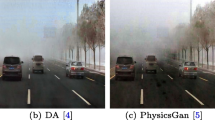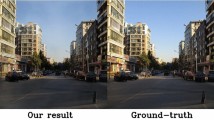Abstract
Image dehazing has always been a challenging topic in image processing. The development of deep learning methods, especially the generative adversarial networks (GAN), provides a new way for image dehazing. In recent years, many deep learning methods based on GAN have been applied to image dehazing. However, GAN has two problems in image dehazing. Firstly, For haze image, haze not only reduces the quality of the image but also blurs the details of the image. For GAN network, it is difficult for the generator to restore the details of the whole image while removing the haze. Secondly, GAN model is defined as a minimax problem, which weakens the loss function. It is difficult to distinguish whether GAN is making progress in the training process. Therefore, we propose a guided generative adversarial dehazing network (GGADN). Different from other generation adversarial networks, GGADN adds a guided module on the generator. The guided module verifies the network of each layer of the generator. At the same time, the details of the map generated by each layer are strengthened. Network training is based on the pre-trained VGG feature model and L1-regularized gradient prior which is developed by new loss function parameters. From the dehazing results of synthetic images and real images, the proposed method is better than the state-of-the-art dehazing methods.





Similar content being viewed by others
References
Ahmad MZ, Peters JF (2020) Fuzzy hyperconnected proximity spaces and fuzzy summability over CW complexes. Application of Smirnov fuzzy similarity in video analysis. Soft Comput. https://doi.org/10.1007/s00500-020-04945-1
An F (2020) Image classification algorithm based on stacked sparse coding deep learning model-optimized kernel function nonnegative sparse representation. Soft Comput 24(22):16967–16981
Cai B et al (2016) Dehazenet: an end-to-end system for single image haze removal. IEEE Trans Image Process 25(11):5187–5198
Caviglione L, Gaggero M, Paolucci M et al (2020) Deep reinforcement learning for multi-objective placement of virtual machines in cloud datacenters. Soft Comput. https://doi.org/10.1007/s00500-020-05462-x
Chen W-T et al (2020) PMHLD: patch map-based hybrid learning DehazeNet for single image haze removal. IEEE Trans Image Process 29:6773–6788
Dai C et al (2020) Single hazy image restoration using robust atmospheric scattering model. Signal Process 166:107257
Deldjoo Y, Di Noia T, Merra FA (2021) A survey on adversarial recommender systems: from attack/defense strategies to generative adversarial networks. ACM Comput Surv 54(2):1–38
Dharejo FA et al (2021) A remote-sensing image enhancement algorithm based on patch-wise dark channel prior and histogram equalisation with colour correction. IET Image Proc 15(1):47–56
Dong H, Pan J et al (2020) Multi-scale boosted dehazing network with dense feature fusion. In: Proceedings of the IEEE/CVF conference on computer vision and pattern recognition, pp 2157–2167
Dudhane A, Murala S (2019) RYF-Net: deep fusion network for single image haze removal. IEEE Trans Image Process 29(2019):628–640
Du Y, Li X (2018) Recursive deep residual learning for single image dehazing. In: Proceedings of the IEEE conference on computer vision and pattern recognition workshop
Engin D, Genç A, Ekenel HK (2018) Cycle-dehaze: enhanced cyclegan for single image dehazing. In: Proceedings of the IEEE conference on computer vision and pattern recognition workshops
Goodfellow IJ et al (2014) Generative adversarial networks. arXiv preprint arXiv:1406.2661
Gui J et al (2020) A review on generative adversarial networks: algorithms, theory, and applications. arXiv preprint arXiv:2001.06937
He K, Sun J, Tang X (2010) Single image haze removal using dark channel prior. IEEE Trans Pattern Anal Mach Intell 33(12):2341–2353
Helmrich CR et al (2020) Xpsnr: a low-complexity extension of the perceptually weighted peak signal-to-noise ratio for high-resolution video quality assessment. In: ICASSP 2020-2020 IEEE international conference on acoustics, speech and signal processing (ICASSP). IEEE
Hou G, Li J, Wang G et al (2020) A novel dark channel prior guided variational framework for underwater image restoration. J Vis Commun Image Represent 66:102732
Huang X et al (2021) A two-sided matching model for complex equipment production of military–civilian merging platform with reference effects. Soft Comput 25:1–23
Huynh L et al (2020) Guiding monocular depth estimation using depth-attention volume. In: European conference on computer vision. Springer, Cham
Iwamoto Y, Hashimoto N, Chen Y-W (2020) Real-time haze removal using normalised pixel-wise dark-channel prior and robust atmospheric-light estimation. Appl Sci 10(3):1165
Janai J et al (2020) Computer vision for autonomous vehicles: problems, datasets and state of the art. Found Trends Comput Graph Vis 12(1–3):1–308
Jin C et al (2020) Similarity measurement on human mobility data with spatially weighted structural similarity index (SpSSIM). Trans GIS 24(1):104–122
Ju M et al (2021) IDE: image dehazing and exposure using an enhanced atmospheric scattering model. IEEE Trans Image Process 30:2180–2192
Ju M, Zhang D, Wang X (2017) Single image dehazing via an improved atmospheric scattering model. Vis Comput 33(12):1613–1625
Karras T et al (2020) Training generative adversarial networks with limited data. arXiv preprint arXiv:2006.06676
Kendall A, Yarin G (2017) What uncertainties do we need in Bayesian deep learning for computer vision? arXiv preprint arXiv:1703.04977
Khan S et al (2018) A guide to convolutional neural networks for computer vision. Synth Lect Comput Vis 8(1):1–207
Li B et al (2017) Aod-net: all-in-one dehazing network. In: Proceedings of the IEEE international conference on computer vision, pp 4770–4778
Li B et al (2021) You only look yourself: unsupervised and untrained single image dehazing neural network. Int J Comput Vis 129:1–14
Lin J, Li Y, Yang G (2021) FPGAN: face de-identification method with generative adversarial networks for social robots. Neural Netw 133:132–147
McCartney EJ (1976) Optics of the atmosphere: scattering by molecules and particles. New York
Nanni L, Ghidoni S, Brahnam S (2017) Handcrafted vs. non-handcrafted features for computer vision classification. Pattern Recogn 71:158–172
O’Mahony N et al (2019) Deep learning vs. traditional computer vision. Science and information conference. Springer, Cham
Preethaa KRS, Sabari A (2020) Intelligent video analysis for enhanced pedestrian detection by hybrid metaheuristic approach. Soft Comput 24:1–9
Qian W, Zhou C, Zhang D (2020) FAOD-Net: a fast AOD-Net for dehazing single image. Math Probl Eng 2020:4945214. https://doi.org/10.1155/2020/4945214
Rani S, Kaur M, Kumar M et al (2021) Detection of shilling attack in recommender system for YouTube video statistics using machine learning techniques. Soft Comput. https://doi.org/10.1007/s00500-021-05586-8
Ren W et al (2016) Single image dehazing via multi-scale convolutional neural networks. In: European conference on computer vision. Springer, Cham, pp 154–169
Sagar A (2020) Monocular depth estimation using multi scale neural network and feature fusion. arXiv preprint arXiv:2009.09934
Schonfeld E, Schiele B, Khoreva A (2020) A u-net based discriminator for generative adversarial networks. In: Proceedings of the IEEE/CVF conference on computer vision and pattern recognition
Sekh AA et al (2020) Video trajectory analysis using unsupervised clustering and multi-criteria ranking. Soft Comput 24:16643–16654
Shyam P, Yoon K-J, Kim K-S (2021) Towards domain invariant single image dehazing. arXiv preprint arXiv:2101.10449
Sohn K, Lee H, Yan X (2015) Learning structured output representation using deep conditional generative models. Adv Neural Inf Process Syst 28:3483–3491
Voulodimos A, Doulamis N, Doulamis A, Protopapadakis E (2018) Deep learning for computer vision: a brief review. Comput Intell Neurosci 2018:7068349. https://doi.org/10.1155/2018/7068349
Wang H et al (2021) A novel multi-objective optimization algorithm for the integrated scheduling of flexible job shops considering preventive maintenance activities and transportation processes. Soft Comput 25(4):2863–2889
Yamamoto R, Song E, Kim J-M (2020) Parallel WaveGAN: a fast waveform generation model based on generative adversarial networks with multi-resolution spectrogram. In: ICASSP 2020-2020 IEEE international conference on acoustics, speech and signal processing (ICASSP). IEEE
Zhang J et al (2017) Fast haze removal for nighttime image using maximum reflectance prior. In: Proceedings of the IEEE conference on computer vision and pattern recognition
Zhang S, He F, Ren W (2020) NLDN: non-local dehazing network for dense haze removal. Neurocomputing 410:363–373
Zhang J, He F, Chen Y (2020) A new haze removal approach for sky/river alike scenes based on external and internal clues. Multimed Tools Appl 79(3):2085–2107
Zhang J, Feng F, Song W (2021) A compensation textures dehazing method for water alike area. J Supercomput 77(4):3555–3570
Zhao S et al (2021) RefineDNet: a weakly supervised refinement framework for single image dehazing. IEEE Trans Image Process 30:3391–3404
Acknowledgements
This work is supported by East Lake Scholar Program of Wuhan Sports University (Grant No. 201806).
Author information
Authors and Affiliations
Contributions
All authors contributed to the study conception and design. Material preparation, data collection and analysis were performed by Jiang Zhang, Qinqin Dong and Wanjuan Song. The first draft of the manuscript was written by Jian Zhang and all authors commented on previous versions of the manuscript. All authors read and approved the final manuscript.
Corresponding author
Ethics declarations
Conflict of interest
The authors declare that they have no conflicts of interest.
Informed consent
Informed consent was obtained from all individual participants included in the study.
Additional information
Communicated by Mu-Yen Chen.
Publisher's Note
Springer Nature remains neutral with regard to jurisdictional claims in published maps and institutional affiliations.
Rights and permissions
About this article
Cite this article
Zhang, J., Dong, Q. & Song, W. GGADN: Guided generative adversarial dehazing network. Soft Comput 27, 1731–1741 (2023). https://doi.org/10.1007/s00500-021-06049-w
Accepted:
Published:
Issue Date:
DOI: https://doi.org/10.1007/s00500-021-06049-w




